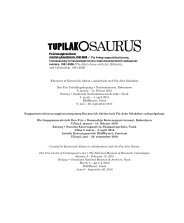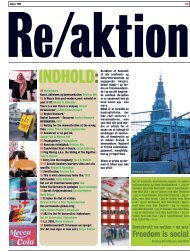tupilakosaurus - Print matters!
tupilakosaurus - Print matters!
tupilakosaurus - Print matters!
Create successful ePaper yourself
Turn your PDF publications into a flip-book with our unique Google optimized e-Paper software.
NIAQQUP SAARNgI SAANI-<br />
KULLU QALLORLUgIT<br />
naatsukullammik allagartalerpaa:<br />
“Niaqqup saarngi saanikullu qallorlugit<br />
sanileriiarpakka – side by side –<br />
nuannarineqarpianngilaq quianarpasillunili.”<br />
Malitassiuinermik oqarneq soorunami ingasaassineruvoq,<br />
tassami nunasiaajunnaarneq<br />
nammineq pissutsini malillugu qulaaniit<br />
aalajangiiffigineqarsinnaanngilaq. Taassuma<br />
saniatigut sammivarput puigortuusineq puigortuusinermullu<br />
periaatsit, kalaallit danskillu<br />
inissisimaffiini kinguaariinni amerlaqisuni<br />
atuuttuarsimasut, imaaliallaannaq peerneqarsinnaanngitsut.<br />
Imaassinnaavalumi siunnersuutigineqarsinnaanngilluinnartoq<br />
malitassiap,<br />
allanit paasineqarsinnaanngitsutut ittup, malinneqarnissaa?<br />
Londonimi Goldsmits-imi nunasiaareersimanerup<br />
kingunerinik ilisimatusarfimmi ilinniartitsisup,<br />
lektor Francoise Vergès-ip, puigortuusinerit,<br />
nunasiaatip tarninganiittut, assigiinngitsunut<br />
marlunnut immikkoortippai: Qanganisarpalunnermut<br />
aalajangeerusunnermullu. Qanganisarpaluttumik<br />
puigortuusisitsinerup oqaluttuarisaaneq<br />
ingerlattarpaa pisimasut ilaasa ilumuunnginnerarnerisigut,<br />
tamannalu pissutigalugu ullumi<br />
uagutsinnut aliortukkatut takkuttuartittarlugit.<br />
Oqaatigineqarsinnaanngitsut, nunasiaateqalernerup<br />
ilumut pisimaneranik siornatigullu<br />
amiilaarnartut saqqummiunneqarnissaannik annilaanganeq<br />
pissutigalugu – illuatungaaniluunniit<br />
sapiitsuliornerunernik sorsuanngortitsinerit<br />
sinnerilu puigortuusillugit – ilumuunnginneraannarnagit<br />
atorniarneqarsinnaavoq aalajangiiniarnikkut<br />
puigortuusineq. Taamaaliornikkut<br />
siornatigut pisimasut paasineqarsinnaapput<br />
suut annernarsinnaasut takusinnaanngorlugit,<br />
eqqunngitsuliornerit naleqqutinngitsullu,<br />
eqqaaneqanngikkunik tammarumanngitsut,<br />
nassuerutiginerisigut.<br />
Tassanerpiarlu Arke akuliuppoq periarfissarlu<br />
alla ilusilerlugu. “Soorlu oqaluttuarisaanerup<br />
ilaasa immikkut uppernarsaatissaqarluanngitsulluunniit<br />
aggornerisigut, qujanartumilli ilisarititsinertigut<br />
ataaniittut erseqqissusiat saqqummiunneqartarpoq”,<br />
Carsten Juhl issuaraanni.<br />
Tamanna allanit erseqqinnerujussuarmik takutinneqarpoq<br />
assilissani imminnut atasuni Nature<br />
Morte-mi (ilaatigut taaneqartartuni Perlustrationer<br />
1-10) 1994-imeersumi. Illersornissamut ilisimatusarfiup<br />
ilisimatusarnermut atuagaateqarfiani<br />
– ilaatigut ajoqersuiartortitaasimasut,<br />
ilisimatuut nunasisullu Kalaallit Nunaat pillugu<br />
atuakkiaasa naqeqqaarneri amernik ungalullit<br />
– atuakkat sanileriiaarlugit inissinneqarsimasut<br />
akunnerinut “tassaniissangatinngisat” Arkep<br />
ikkussuuppai. Akunnerisaannik allanik tamanik<br />
tikkuussinermigut (oqaluttuarujussuarmi, isummani<br />
tungaviusuni napatitsiniartussani, akunnequtini<br />
eqqaamasanik avataaniititsiniarnerni,<br />
il.il.) Arkep ini kusanassusilik pilersippaa,<br />
taamaalilluni kingunerlutsitsinerit paasineqarsinnaanngitsut<br />
qaqinneqarsinnaalersillugit,<br />
uagullu aallartissinnaalerlugu anamnese, uagut<br />
nammineq nunasiaateqarnitta oqaluttuassartaanik<br />
nassuiaat.<br />
THEME SECTION 7: FISHING OUT SKULLS AND BONES<br />
Pia Arke’s works persistently concerned<br />
themselves with “Greenland as colonial<br />
history, mapmaking, time, recollection,<br />
space, silence, identity and myth”, as she<br />
herself formulated it. Put a little simply,<br />
however, her investigations say just as<br />
much about Denmark and the Danish<br />
mentality.<br />
Denmark’s 250-year presence in<br />
Greenland as a colonial power has left<br />
deep marks on both countries. There<br />
will always be a bond between the two<br />
places and their peoples and cultures,<br />
also despite the fact that the bond<br />
may for various reasons be difficult to<br />
understand in all its facets. And this<br />
is the case even though certain facets<br />
are so traumatising or perhaps overlaid<br />
with so much sense of guilt that they<br />
are repressed, projected onto someone or<br />
something else or transposed into a more<br />
bearable picture.<br />
This section examines the nature of<br />
the traumas that colonialism has left in<br />
us, how the repressed past works in –<br />
and haunts – us from its subconscious<br />
depths, and finally what role art can<br />
play when past events are to be recalled,<br />
traumas given expression and wounds<br />
healed. Our analysis takes its departure<br />
in a number of Arke’s works and their<br />
interplay with the ethnographic museological<br />
frameworks and objects side by<br />
side with which we have installed them<br />
(sometimes harmoniously, sometimes<br />
stridently out of tune).<br />
As a rule the colonial condition is regarded<br />
as over when the colonial power<br />
leaves the colony and yields economic<br />
and political control over the country to<br />
its original inhabitants – whether this<br />
takes place by way of negotiations or<br />
revolt. But postcolonial experience, as<br />
it has especially been expressed in the<br />
literature and theory that arose in the<br />
wake of the great wave of decolonisation<br />
after World War II, shows that there is<br />
no such thing as a clean historical break<br />
between colony and metropole. And the<br />
personal and national-romantic hopes<br />
that it will be possible to “pop” back to<br />
a precolonial identity when the colonial<br />
oppressor disappears have also been<br />
disappointed. The slate has not been<br />
wiped clean of the alienation and shame<br />
that come along with the fact of having<br />
been colonised.<br />
One might be tempted to say that the<br />
colonial power has not disappeared at<br />
all. Or that it has disappeared physically,<br />
while (all or at any rate) parts of its<br />
essence, its habits and values live on in<br />
the colony as an internalised component<br />
in the mentality of the colonised people,<br />
and in the social structures and political<br />
and administrative organs that bind<br />
them together as a culture and nation.<br />
Arke does not in any way condemn<br />
this state of affairs. But her own recipe<br />
for a genuine mental decolonisation is<br />
not exactly designed for sensitive souls.<br />
Thus, she provides a diptych consisting<br />
of two contrasting Greenlandic motifs (a<br />
frozen fjord landscape and an indeterminate<br />
space of an industrial character)<br />
placed opposite each other with this<br />
trenchant verse:<br />
“Fishing out skulls and bones<br />
I place them in a row – side by side –<br />
It is not popular but it looks entertaining”<br />
The recipe is of course a bit of hype,<br />
for decolonisation cannot in the nature<br />
of things be dictated from above. Furthermore,<br />
we are speaking of repressions<br />
and their mechanisms that have been at<br />
work for so many generations in both the<br />
Greenlandic and the Danish camps that<br />
they do not give up the ghost so easily.<br />
And is it at all advisable to follow the<br />
recipe for something that seems indigestible<br />
for others?<br />
Lecturer in postcolonial studies at<br />
Goldsmiths College in London, Françoise<br />
Vergès, distinguishes between two forms<br />
of repression operating in the colonised<br />
psyche: the conservative and the<br />
constitutive. The conservative repression<br />
controls history in a way that persistently<br />
denies certain parts of the past, which<br />
for that reason continue to haunt one in<br />
the present like ghosts from the grave.<br />
Instead of denying the unspeakable<br />
fact that colonisation took place out<br />
of pure fear of reviving the horrors of<br />
the past – or, conversely, instead of<br />
exaggerating its more heroic aspects<br />
and repressing the rest – one can have<br />
recourse to constitutive repression. This<br />
functions in such a way that one can<br />
take in the past sufficiently to be able<br />
to look the pain it caused in the eye, to<br />
acknowledge that there have been unjust<br />
and inappropriate elements that will not<br />
disappear unless they are remembered.<br />
And it is here Arke comes in and<br />
draws the contours of an alternative.<br />
“For example, by cutting the historical<br />
into parts without any special source<br />
status, but which thanks to the biographical<br />
cut succeed in revealing an<br />
underlying clarity”, to quote historian<br />
Carsten Juhl.<br />
Nowhere does this come more clearly<br />
to expression than in the picture series<br />
Nature Morte (sometimes also referred<br />
to as Perlustrations 1-10) from 1994. In<br />
a research library under the Ministry<br />
of Defence – among leather-bound<br />
first editions of works on Greenland by<br />
the early missionaries, scientists and<br />
colonisers – Arke inserts “foreign bodies”<br />
into the cracks between the books as<br />
they stand there lined up on the shelves.<br />
By pointing at all the other cracks (in<br />
the great narrative, in the ideologies<br />
that are supposed to support it, in the<br />
shutters that are meant to keep out the<br />
memories, etc.) she creates an aesthetic<br />
space, where undigested traumas can<br />
come up to the surface, and we can begin<br />
an anamnesis, an account of our own<br />
colonial histories.<br />
53




